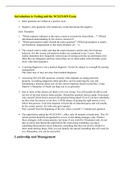Modellen
,Inhoud
1. Info ........................................................................................................................................................................... 4
2. H6:beslissen onder onzekerheid .............................................................................................................................. 5
2.1. EMV and decision trees ................................................................................................................................... 5
2.2. regel van Bayes ................................................................................................................................................ 6
2.3. EVPI: expected value of Perfect Information .................................................................................................. 7
2.4. Risico-aversie ................................................................................................................................................... 7
3. H10 & H11: Lineaire regressie ................................................................................................................................ 10
3.1. Introductie ..................................................................................................................................................... 10
3.2. Kleinstekwadratenmethode .......................................................................................................................... 14
3.3. Assumpties lineaire regressie ........................................................................................................................ 14
3.4. Standaardfout regressie ................................................................................................................................ 15
3.5. Correlatie en determinatiecoëfficiënt ........................................................................................................... 16
3.6. Significantietoetsen regressiemodel ............................................................................................................. 16
3.7. Voorbeeld: toepassing bovenstaande concepten in hetzelfde Excel bestand .............................................. 18
3.8. Modelleren: categorische variabele .............................................................................................................. 20
3.9. Modelleren: interactie ................................................................................................................................... 21
3.10. Voorbeeld modelleren met categorische variabelen .................................................................................... 21
3.11. Voorbeeld modelleren met interactie ........................................................................................................... 23
3.12. Modelleren: niet-lineaire relaties .................................................................................................................. 24
3.13. Multicollineariteit .......................................................................................................................................... 29
3.14. Nagaan regressieassumpties ......................................................................................................................... 30
3.15. Voorspellingen maken ................................................................................................................................... 31
3.16. Voorbeeld nagaan assumpties en berekenen betrouwbaarheid en predictie interval ................................ 32
3.17. Oefeningen .................................................................................................................................................... 36
4. H12: Tijdreeksanalyse en voorspellen .................................................................................................................... 41
4.1. Introductie ..................................................................................................................................................... 41
4.2. Notatie ........................................................................................................................................................... 41
4.3. Tijdreeksdata: trend ...................................................................................................................................... 41
4.4. Tijdreeksdata: seizoenseffecten .................................................................................................................... 42
4.5. Tijdreeksdata: willekeurige afwijkingen (noise) ............................................................................................ 42
4.6. Evaluatiecriteria: hoe goed de voorspellingen zijn........................................................................................ 42
4.7. Modelleren tijdreeks: idee ............................................................................................................................ 43
4.8. Modelleren tijdreeks: autocorrelatie illustreren met voorbeeld .................................................................. 44
4.9. Soorten modellen .......................................................................................................................................... 45
4.10. Regressie: trends en seizoenseffecten .......................................................................................................... 45
4.11. Regressie: assumpties.................................................................................................................................... 46
4.12. Autoregressief model .................................................................................................................................... 49
4.13. Autoregressief model: moeilijkheid .............................................................................................................. 49
4.14. Autoregressief model: random walk ............................................................................................................. 50
4.15. Smoothing methoden .................................................................................................................................... 52
2
, 4.16. Voorbeelden .................................................................................................................................................. 58
5. H17: Data Mining ................................................................................................................................................... 60
5.1. Inleiding: soorten analyses ............................................................................................................................ 60
5.2. Inleiding: leerparadigma’s ............................................................................................................................. 60
5.3. Training data en testing data ......................................................................................................................... 60
5.4. Classificatiemethoden ................................................................................................................................... 60
5.5. Logistische regressie: idee ............................................................................................................................. 60
5.6. Logistische regressie: schatten model ........................................................................................................... 61
5.7. Logistische regressie: schatten model ........................................................................................................... 62
5.8. Logistische regressie: beoordelen parameters.............................................................................................. 63
5.9. Logistische regressie: interpreteren coëfficiënten ........................................................................................ 63
5.10. Logistische regressie: voorbeeld ................................................................................................................... 64
5.11. Naïve bayes.................................................................................................................................................... 68
5.12. Neurale netwerken ........................................................................................................................................ 70
5.13. Classification trees ......................................................................................................................................... 71
5.14. Evalueren nauwkeurigheid classificaties ....................................................................................................... 71
5.15. Clustering ....................................................................................................................................................... 72
5.16. Clustering: K-means algoritme ...................................................................................................................... 73
5.17. Oefeningen .................................................................................................................................................... 73
3
, 1. Info
4










